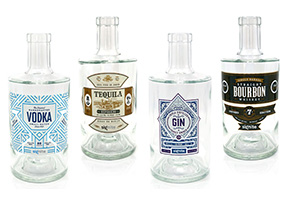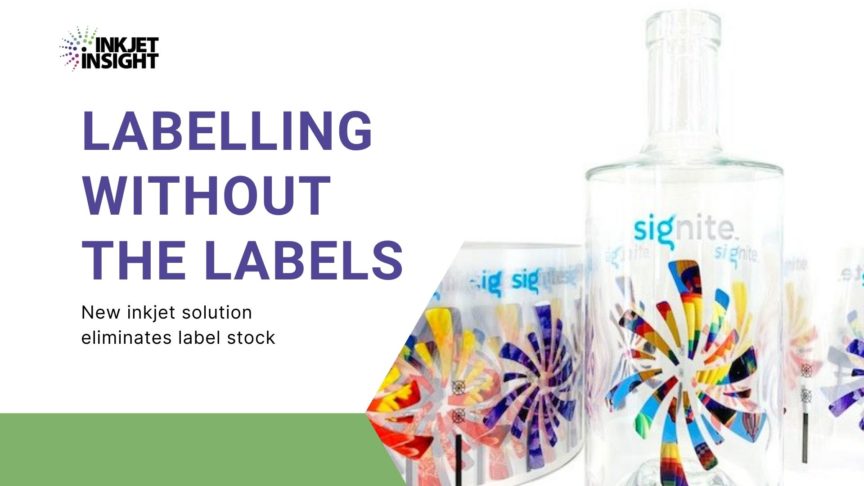Everyone involved in label printing will be familiar with the ‘no-label’ concept where a graphic is printed onto a transparent label stock, which is particularly effective on clear glass and plastic bottles as the graphic seems to float on the bottle’s surface. Actega has now gone a step further with its new Signite solution by doing away with the label stock, which creates a unique graphic effect and significantly cuts down on the amount of plastic used.

In this story I’m going to cover the printing of Signite labels. I’ll follow this up next week with a second story on applying those labels to their containers and the implications for the recycling of those containers.
The basic principle behind printing a Signite label is fairly simple, starting with a carrier film, which has a release coating on the reverse to prevent blocking when the substrate is wound up after printing. The first stage is to print the graphic onto this carrier film. That involves first laying down a clear coating, which Actega refers to as the L3 layer. Then the CMYK ink layer is reverse printed on top of this clear coating. Finally, an adhesive layer is added on top. This sandwich – clear coating plus ink and adhesive – is then peeled off the carrier film and applied to the container, which Actega says results in a label that’s up to three times thinner than a standard pressure sensitive label.
This process was originally designed to work with narrow web flexo printing though the press will need to reconfigured. Initially, Actega outsourced the printing to a local converter with a Nilpeter flexo press near its R&D base in Rhode Island, USA, before buying its own Mark Andy hybrid press.
Tony Carignano, technical director of marketing at Actega North America, says: “We really quickly found out a couple of things, that each press has its own personality and when you are directly printing, as opposed to indirectly printing with digital heads where you are shooting droplets versus using flexographic plates that directly touch the surface, so we found that using a direct printing 100 percent flexo process is really hard to do with printing Signite because you are printing only the image itself onto a container. You are literally only printing about 24-25 microns of material onto a carrier film and then transferring over to a container with a piece of application hardware. So we found that the more touch points that you have with the fluids, with any type of surface or any type of piece of equipment, is opening up issues with picking or delamination or other types of issues that you don’t want to have when you are laying down such a thin film.”
He adds: “We currently use a Mark Andy hybrid digital press to print Signite. The press uses both UV curing on the flexo stations at the beginning of the press where our L3 liquid laminate layer is applied. The press uses intra-colour UV-LED pinning on the piezo digital inkjet portion of the press. The final Flexo print station on the press uses UV curing.”
Carignano says that Signite can be printed on any narrow web flexo press with UV curing on all stations, but notes: “Compared with conventional UV narrow web flexo printing, Actega has learned that print registration on a hybrid digital press is achievable with much less difficulty. Mark Andy’s HD press creates significantly less print waste and perfectly suits ultra-short Signite print runs. In addition, there is much less physical UV flexo station-to-station contact with the Signite L3 layer. Thus, the HD press printing process creates much fewer opportunities for producing image ‘picking’ and de-lamination from the Signite carrier film.”
That said, the process can be run on a flexo press. He adds further: “Although the pre-press artwork aspects of printing Signite are not challenging to learn, significant press set-up learnings would need to be transferred face-to-face before Signite could be successfully printed using a conventional 100 percent UV flexo press.” Apart from the training the operator, the narrow web flexo press would have to be modified and converters would have to consider the implications this might have on warranties and service plans for that press unless Actega can come to an arrangement with the press manufacturers. Carignano says: “We know it’s doable because we had to do it ourselves.” Printing Signite does not affect the running speed of either a flexo or digital hybrid press with Actega currently achieving speeds of 150 to 200fpm or 45 to 60mpm.
Carignano explains: “Based on Actega’s experience on press, we estimate that to retrofit an existing inline narrow web UV press for printing Signite will cost US$8,000. This assumes that the UV flexo press has already been geared with the appropriate servo-driven tension controls and auto-registration capabilities to run thin, unsupported carrier films.” That would rule out older mechanically-driven presses but this shouldn’t be a problem for most label converters since most modern narrow web presses do use servos throughout, including most entry-level models, specifically so that they can handle thin films.
He adds: “In addition, the rollers used for the pressure sensitive have to be changed out to teflon rollers so that you don’t get tacking or agglomeration of the pressure sensitive adhesive. Our process is like printing in reverse because instead of the overprint varnish being printed last, we’re printing that first so the clear station would have to go on the front end of the press, followed by the process colours and we typically apply our white as one of the last stations before applying the pressure sensitive adhesive. The pressure sensitive adhesive, before we had to put a liner film down and make a sandwich so that you wouldn’t get tacking but we have found a way around that by putting the front on the backside of the carrier film so that you don’t get blocking of the roll.”
UV-curable ink
Initially the process was designed for use on flexo presses, and so the clear coating and the ink was a mixture of photopolymeric monomers and oligomers along with photo-initiators and additives. Using the hybrid approach, the UV digital inkjet inks are monomer rich so that they have to be optimised for a given press and it follows that the inks have been developed for use with the Mark Andy hybrid that Actega has been using.
Carignano says that it should be relatively easy to optimise the process for other printheads, noting: “It’s photopolymer chemistry so it’s basically compatibilising a digital inkjet low viscosity fluid that’s UV curable with an L3 layer, the clear layer that you lay down first, which is also UV curable so it’s really not that difficult to do. There is some tweaking that would have to take place to the L3 layer, the clear coating that goes down first, but it really is not picoliter-sized dependent, it’s more chemistry dependent in making sure that you are getting good hedging of the clear coating with the process colours that are applied over the top of them.”
Actega is also working on a version for use with piezo inkjet label presses though there’s no date yet for when this will be commercially available.
For now, the process uses CMYK but Carignano says that the plan is to introduce more colours, noting: “We currently on the Mark Andy can do up to two spot Pantone colours but we realise that extended gamut and the ability to print much more than CMYK is extremely important in the market.” Actega has already produced some stunning samples using metallic effects and is working with Eckhardt’s gold pigments for this.
Conclusion
So far I’ve only written about some of the considerations in developing the printing side of the Signite labels. In the second half of this story I’ll cover the process for applying Signite to the containers and the implications of this approach, particularly in terms of recycling and the sustainability of this technology.
In the meantime, it’s worth noting that Signite is capable of producing some extremely striking designs whilst also significantly reducing the amount of plastic label stock used. In terms of cost compared against pressure-sensitive labels, Carignano says: “In lower volume higher image complexity applications, Signite is an outstanding replacement for conventional pressure sensitive labelling and is cost competitive. We have yet to develop the application hardware that would allow us to be cost competitive for high volume fast moving CPG commoditized product applications.”
Stay tuned for the second half of this story. In the meantime, you can find more information from actega.com.

